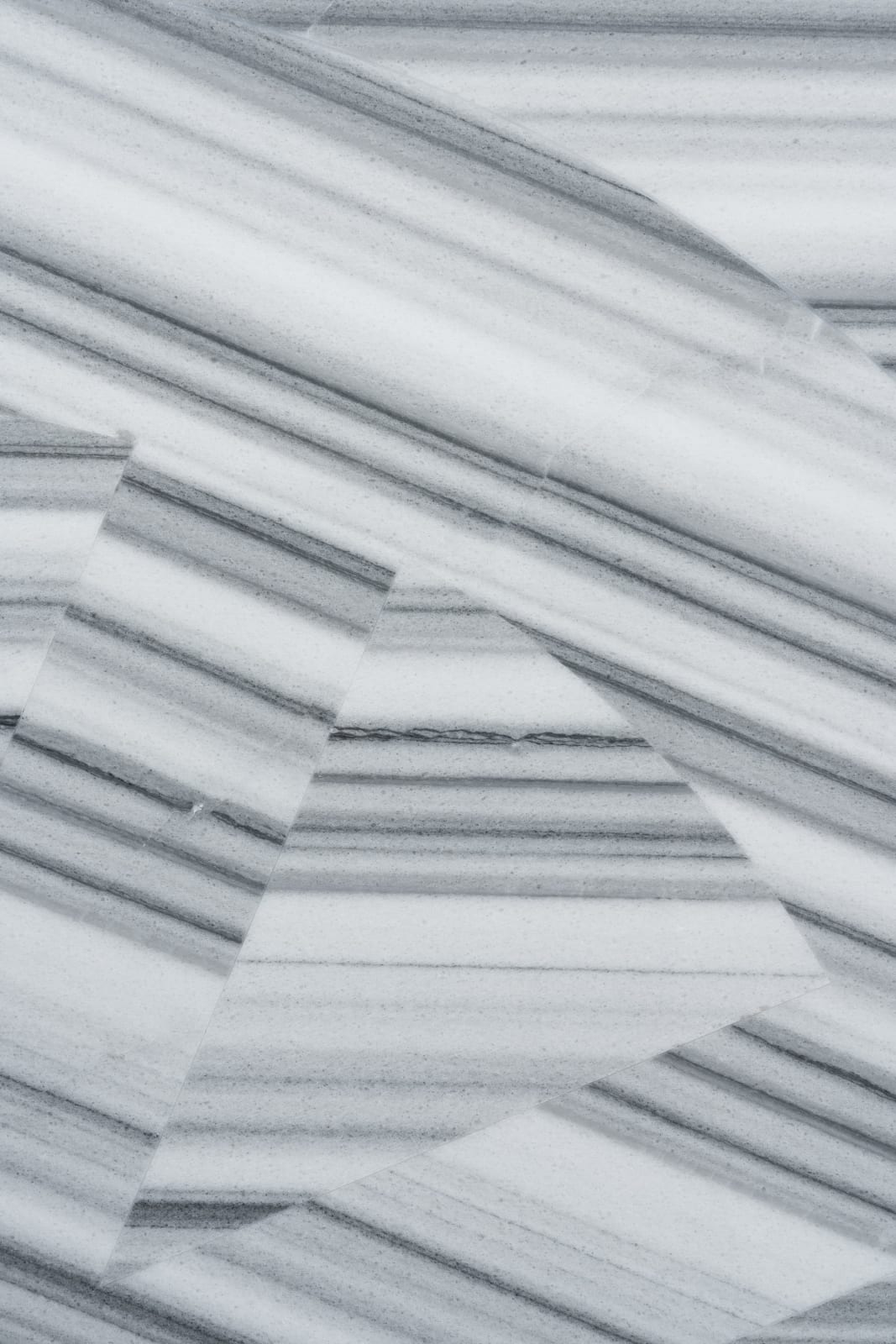Lou Jaworski
ZENIT, 2025
Striato Olimpico marble intarsia
149 x 149 cm
58 5/8 x 58 5/8 inches
58 5/8 x 58 5/8 inches
Copyright The Artist
Photo: Dirk Tacke
Further images
Die Werke aus der Serie „EOS“ (2025) und „ZENIT“ sind Intarsienarbeiten aus Stein, in der Jahrtausende alte Maserungen präzise geometrische Formen bilden. Durch das Suchen der geeigneten Steine, Schneiden, Versetzen...
Die Werke aus der Serie „EOS“ (2025) und „ZENIT“ sind Intarsienarbeiten aus Stein, in der Jahrtausende alte Maserungen präzise geometrische Formen bilden. Durch das Suchen der geeigneten Steine, Schneiden, Versetzen und Einlegen der Intarsien entstehen symbolische Bilder, die durch die Verschiebung des Materials sichtbar werden. Damit greift Jaworski in die geologische Struktur des Striato Olimpico Marmors ein, und fügt ihm eine neue Ordnung und Symbolsprache hinzu: das Rad als Zeichen der Bewegung und des technologischen Fortschritts, der Kreis als Bild für das kosmische Ganze und stetigem Wandel. Die natürliche Unterteilung des Marmors, die sich in Streifen über den Stein zieht lässt den Blick, wie auch bei der Werkserie „STRATOS“ 2023/2024 zwischen Bildträger und Bild springen. In der neuen Werkserie verzichtet Jaworski auf Überlagerungen mittels UV-Druck und arbeitet allein mit der Struktur des Steins. So wird der Marmor als skulpturales Material hier nicht nur zum Bildträger, sondern gleichzeitig zum Bildinhalt. Jaworski beschäftigt sich intensiv mit Wahrnehmungsmechanismen und der Definition des Bildbegriffs. Wiederholungen Im Sinne einer Xero Kopie, eines Filmkaders, oder eines digitalen Bildes tauchen hier immer wieder auf. So wirken die eingelassenen Formen in ihrer strengen Geometrie wie digitale Ebenen, die über die Oberfläche gelegt wurden, und verwandeln den Stein in eine modellhafte Landschaft, in der organische, gewachsene Strukturen auf die Idee von Konstruktion und Transformation treffen. Der Stein selbst wird zur Hyle: ein Grundmaterial, das gleichzeitig fertig und unfertig ist, offen für Interpretation und neue Bedeutungen. Gleichzeitig verweist Jaworski auf Material als Erinnerungsspeicher – die Streifen und Muster des Steins erzählen ebenso von geologischen Prozessen, von Wasser, Ruhe, und Zeit.
The works from the series “EOS” (2025) and “ZENIT” are inlaid stone works in which millennia-old grain patterns form precise geometric shapes. By searching for suitable stones, cutting, moving and inserting the inlays, he creates symbolic images that become visible through the shifting of the material. Jaworski thereby intervenes in the geological structure of the Striato Olimpico marble and adds a new order and symbolic language to it: the wheel as a sign of movement and technological progress, the circle as an image of the cosmic whole and constant change. The natural division of the marble, which runs in stripes across the stone, allows the eye to jump between the picture carrier and the picture, as in the “STRATOS” 2023/2024 series of works. In the new series of works, Jaworski dispenses with overlays using UV printing and works solely with the structure of the stone. In this way, the marble as a sculptural material not only becomes the image carrier, but also the image content. Jaworski deals intensively with mechanisms of perception and the definition of the concept of the image. Repetitions in the sense of a xero copy, a film frame or a digital image appear here again and again. The recessed forms in their strict geometry thus appear like digital layers laid over the surface, transforming the stone into a model-like landscape in which organic, grown structures meet the idea of construction and transformation. The stone itself becomes a hyle: a basic material that is both finished and unfinished, open to interpretation and new meanings. At the same time, Jaworski refers to material as a memory store - the stripes and patterns of the stone also tell of geological processes, of water, tranquility and time.
The works from the series “EOS” (2025) and “ZENIT” are inlaid stone works in which millennia-old grain patterns form precise geometric shapes. By searching for suitable stones, cutting, moving and inserting the inlays, he creates symbolic images that become visible through the shifting of the material. Jaworski thereby intervenes in the geological structure of the Striato Olimpico marble and adds a new order and symbolic language to it: the wheel as a sign of movement and technological progress, the circle as an image of the cosmic whole and constant change. The natural division of the marble, which runs in stripes across the stone, allows the eye to jump between the picture carrier and the picture, as in the “STRATOS” 2023/2024 series of works. In the new series of works, Jaworski dispenses with overlays using UV printing and works solely with the structure of the stone. In this way, the marble as a sculptural material not only becomes the image carrier, but also the image content. Jaworski deals intensively with mechanisms of perception and the definition of the concept of the image. Repetitions in the sense of a xero copy, a film frame or a digital image appear here again and again. The recessed forms in their strict geometry thus appear like digital layers laid over the surface, transforming the stone into a model-like landscape in which organic, grown structures meet the idea of construction and transformation. The stone itself becomes a hyle: a basic material that is both finished and unfinished, open to interpretation and new meanings. At the same time, Jaworski refers to material as a memory store - the stripes and patterns of the stone also tell of geological processes, of water, tranquility and time.
1
of
8









